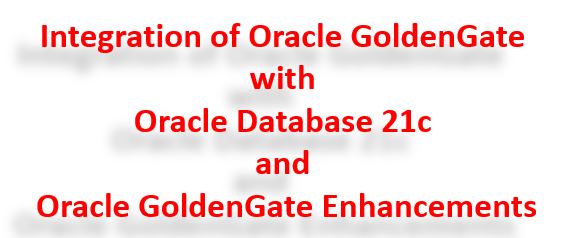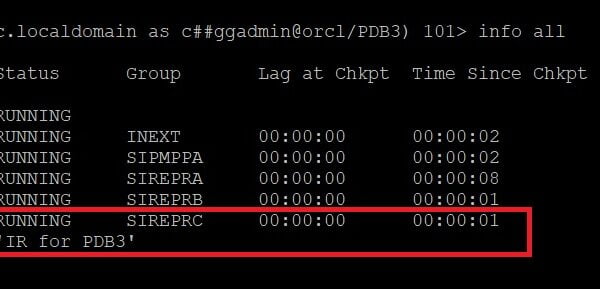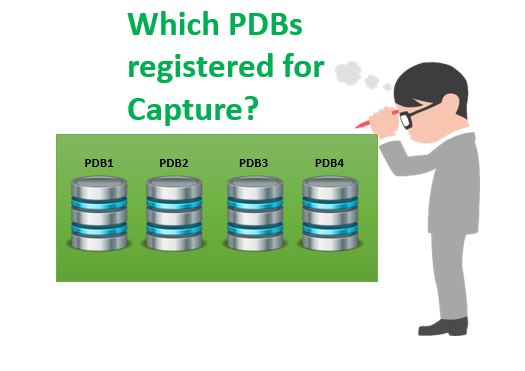Each and every processes in Oracle GoldenGate has it’s own checkpoints to maintain data integrity.
This article explains the different types of checkpoints and the uses of it.
As we know there are multiple processes involved in Oracle GoldenGate replication, the below are the processes which maintains the checkpoint information for each and every operations it does.,
1. Extract or Capture Process
2. Secondary Extract or DataPump Process
3. Replicat Process
EXTRACT PROCESS
This process captures the committed changes from the Redo Log or Archive Log files and writes them to the Trail files called Local Trails. The Extract Process
not only captures the committed changes but also keeps track of all the Open transactions so that it ensures that it does not misses any data or no data loss.
The Extract Process maintains the below checkpoints,
1. Startup Checkpoint
2. Current Read Checkpoint
3. Recovery Checkpoint
4. Current Write Checkpoint
STARTUP CHECKPOINT
Whenever an Extract process is started, it makes it’s first checkpoint in the data source. The first checkpoint made in the data source when the extract process starts is the STARTUP CHECKPOINT.
Read Checkpoint #1 Oracle Redo Log Startup Checkpoint (starting position in the data source): Thread #: 1 Sequence #: 258 RBA: 11913232 Timestamp: 2015-12-25 20:38:13.000000 SCN: 0.3302225 (3302225) Redo File: /vol3/GGDB1/redo03.log
CURRENT READ CHECKPOINT
The Extract process reads from the Redo Logs or Archive Log files. This Checkpoint shows the current read position of the Extract process. It shows the information of the extract process where currently it is reading like, which is the current redo log or archive log file.
Current Checkpoint (position of last record read in the data source): Thread #: 1 Sequence #: 260 RBA: 25050112 Timestamp: 2015-12-26 12:02:17.000000 SCN: 0.3333968 (3333968) Redo File: /vol2/GGDB1/redo02.log
RECOVERY CHECKPOINT
As I mentioned earlier, the extract process not only captures the committed changes from the redo or archive log files but also keeps track of all the open transaction
so that it ensures that it does not misses any data or no data loss.
This is the checkpoint which shows the Oldest Open transaction in the database.
Recovery Checkpoint (position of oldest unprocessed transaction in the data source): Thread #: 1 -------------------> This is the Single Instance, so the number of thread is 1 Sequence #: 260 ---------------> Redo Log sequence number RBA: 25021456 Timestamp: 2015-12-26 12:01:21.000000 SCN: 0.3333913 (3333913) Redo File: /vol2/GGDB1/redo02.log
CURRENT WRITE CHECKPOINT
Extract process captures the changes from the redo log or archive log files and writes these changes to the Trail files called Local Trails. The CURRENT WRITE CHECKPOINT show the information
of the extract process where it is currently writing. It means the information like, to which trail file sequence and RBA it is currently writing to.
Write Checkpoint #1 GGS Log Trail Current Checkpoint (current write position): Sequence #: 11 --------------> The Trail file sequence number to which the Extract Process is writing to. RBA: 1468 --------------> Relative Byte Address Timestamp: 2015-12-26 12:02:20.784341 Extract Trail: /vol3/ogg/dirdat/et Trail Type: EXTTRAIL
The below command is executed to know all the checkpoint information of the Extract Process.
INFO EXTRACT <EXTRACT_NAME>, SHOWCH
Below is the example of the above commands output. Here my extract name is EXT1,
GGSCI (OGG1.localdomain) 8> INFO EXTRACT EXT1, SHOWCH EXTRACT EXT1 Last Started 2015-12-26 11:32 Status RUNNING Checkpoint Lag 00:00:00 (updated 00:00:06 ago) Process ID 4790 Log Read Checkpoint Oracle Redo Logs 2015-12-26 12:02:17 Seqno 260, RBA 25050112 SCN 0.3333968 (3333968) Current Checkpoint Detail: Read Checkpoint #1 Oracle Redo Log Startup Checkpoint (starting position in the data source): Thread #: 1 Sequence #: 258 RBA: 11913232 Timestamp: 2015-12-25 20:38:13.000000 SCN: 0.3302225 (3302225) Redo File: /vol3/GGDB1/redo03.log Recovery Checkpoint (position of oldest unprocessed transaction in the data source): Thread #: 1 Sequence #: 260 RBA: 25021456 Timestamp: 2015-12-26 12:01:21.000000 SCN: 0.3333913 (3333913) Redo File: /vol2/GGDB1/redo02.log Current Checkpoint (position of last record read in the data source): Thread #: 1 Sequence #: 260 RBA: 25050112 Timestamp: 2015-12-26 12:02:17.000000 SCN: 0.3333968 (3333968) Redo File: /vol2/GGDB1/redo02.log Write Checkpoint #1 GGS Log Trail Current Checkpoint (current write position): Sequence #: 11 RBA: 1468 Timestamp: 2015-12-26 12:02:20.784341 Extract Trail: /vol3/ogg/dirdat/et Trail Type: EXTTRAIL Header: Version = 2 Record Source = A Type = 10 # Input Checkpoints = 1 # Output Checkpoints = 1 File Information: Block Size = 2048 Max Blocks = 100 Record Length = 2048 Current Offset = 0 Configuration: Data Source = 3 Transaction Integrity = 1 Task Type = 0 Status: Start Time = 2015-12-26 11:32:46 Last Update Time = 2015-12-26 12:02:20 Stop Status = A Last Result = 400
DATAPUMP PROCESS
The DataPump process reads the changes from the Local Trail Files, pumps the changes to the target side and writes it to the Target Trail files called Remote Trails.
This process also has three main checkpoints.
1. Startup Checkpoint
2. Current Read Checkpoint
3. Current Write Checkpoint
Here for the DataPump the read checkpoint will be in Local Trails and write checkpoint will be in the Remote Trails. Let us see in depth about it.
STARTUP CHECKPOINT
The first checkpoint made in the Local Trail when the Pump process starts is the STARTUP CHECKPOINT.
GGS Log Trail Startup Checkpoint (starting position in the data source): Sequence #: 10 RBA: 792627 Timestamp: 2015-12-25 18:57:54.000000 Extract Trail: /vol3/ogg/dirdat/et
CURRENT READ CHECKPOINT
DataPump process reads the changes from the Local Trail files which are written by the Extract Process. So the Pump’s read checkpoint shows the information of the
process, like which record it is currently reading and from which Local Trail file it is reading.
Current Checkpoint (position of last record read in the data source): Sequence #: 11 --------------> Local Trail Sequence Number RBA: 1468 -------------------> RBA information in the Local Trail Timestamp: 2015-12-26 11:32:46.875773 Extract Trail: /vol3/ogg/dirdat/et
CURRENT WRITE CHECKPOINT
As explained earlier, the Pump process reads the changes from the Local Trails and writes it to the Remote Trails. So this shows, at which Remote Trail file sequence and RBA the Pump process
is writing to.
Write Checkpoint #1 GGS Log Trail Current Checkpoint (current write position): Sequence #: 17 -----------------> Remote Trail Sequence Number RBA: 1513 ----------------------> RBA Information in the Remote Trail Timestamp: 2015-12-26 12:06:05.789294 Extract Trail: /vol3/ogg/dirdat/et Trail Type: RMTTRAIL
The same command as we used in Extract process is used here to know the checkpoint information. Please check the below example,
INFO EXTRACT <DATAPUMP_NAME>, SHOWCHGGSCI (OGG1.localdomain) 9> INFO EXTRACT DMP1, SHOWCH EXTRACT DMP1 Last Started 2015-12-26 11:32 Status RUNNING Checkpoint Lag 00:00:00 (updated 00:00:05 ago) Process ID 4789 Log Read Checkpoint File /vol3/ogg/dirdat/et000011 2015-12-26 11:32:46.875773 RBA 1468 Current Checkpoint Detail: Read Checkpoint #1 GGS Log Trail Startup Checkpoint (starting position in the data source): Sequence #: 10 RBA: 792627 Timestamp: 2015-12-25 18:57:54.000000 Extract Trail: /vol3/ogg/dirdat/et Current Checkpoint (position of last record read in the data source): Sequence #: 11 RBA: 1468 Timestamp: 2015-12-26 11:32:46.875773 Extract Trail: /vol3/ogg/dirdat/et Write Checkpoint #1 GGS Log Trail Current Checkpoint (current write position): Sequence #: 17 RBA: 1513 Timestamp: 2015-12-26 12:06:05.789294 Extract Trail: /vol3/ogg/dirdat/et Trail Type: RMTTRAIL Header: Version = 2 Record Source = A Type = 1 # Input Checkpoints = 1 # Output Checkpoints = 1 File Information: Block Size = 2048 Max Blocks = 100 Record Length = 2048 Current Offset = 0 Configuration: Data Source = 0 Transaction Integrity = 1 Task Type = 0 Status: Start Time = 2015-12-26 11:32:44 Last Update Time = 2015-12-26 12:06:05 Stop Status = A Last Result = 400
REPLICAT PROCESS
The role of the Replicat process is to read the changes from the Remote Trail file and apply the changes to the target database. As every process has, this process also have the
below checkpoints,
1. Startup Checkpoint
2. Current Read Checkpoint
This process does not have any Write Checkpoints since it is applying the changes to the database.
STARTUP CHECKPOINT
The first checkpoint made in the Remote Trail when the Replicat Process starts is the Startup Checkpoint.
GGS Log Trail Startup Checkpoint (starting position in the data source): Sequence #: 15 RBA: 956263 Timestamp: 2015-12-25 18:57:40.453113 Extract Trail: /vol3/ogg/dirdat/et
CURRENT READ CHECKPOINT
This Checkpoint shows the last transaction read by the Replicat Process from the Remote Trail file. The sequence number of the Remote Trail and the RBA information.
Current Checkpoint (position of last record read in the data source): Sequence #: 17 ----------------> Remote Trail Sequence Number RBA: 1513 ---------------------> RBA information in the Remote Trail Timestamp: 2015-12-26 11:32:44.580331 Extract Trail: /vol3/ogg/dirdat/et
The below command is executed to know all the checkpoint information of the Replicat Process.
INFO REPLICAT <REPLICAT_NAME>, SHOWCHCheck the below example.
GGSCI (OGG2.localdomain) 3> INFO REPLICAT REP1, SHOWCH REPLICAT REP1 Last Started 2015-12-26 11:32 Status RUNNING Checkpoint Lag 00:00:00 (updated 00:00:07 ago) Process ID 4880 Log Read Checkpoint File /vol3/ogg/dirdat/et000017 2015-12-26 11:32:44.580331 RBA 1513 Current Checkpoint Detail: Read Checkpoint #1 GGS Log Trail Startup Checkpoint (starting position in the data source): Sequence #: 15 RBA: 956263 Timestamp: 2015-12-25 18:57:40.453113 Extract Trail: /vol3/ogg/dirdat/et Current Checkpoint (position of last record read in the data source): Sequence #: 17 RBA: 1513 Timestamp: 2015-12-26 11:32:44.580331 Extract Trail: /vol3/ogg/dirdat/et Header: Version = 2 Record Source = A Type = 1 # Input Checkpoints = 1 # Output Checkpoints = 0 File Information: Block Size = 2048 Max Blocks = 100 Record Length = 2048 Current Offset = 0 Configuration: Data Source = 0 Transaction Integrity = -1 Task Type = 0 Database Checkpoint: Checkpoint table = ggadmin.ggschkpt Key = 4074703616 (0xf2df0b00) Create Time = 2015-12-25 15:41:35 Status: Start Time = 2015-12-26 11:32:55 Last Update Time = 2015-12-26 12:06:18 Stop Status = A Last Result = 400
Hope you understood clearly about the Oracle GoldenGate Checkpoints of each and every processes involved in the replication. There is also something called Oracle GoldenGate CHECKPOINT TABLE. This table is maintained in the target side by the REPLICAT PROCESS.
Please check the next post to know about the Oracle GoldenGate Checkpoint Table.
Thanks for your support. Enjoy :)









 Total Users : 1882510
Total Users : 1882510
Hi All,
It is very nice post……
Thanks for sharing…..
I tried to find those information in ggserr.log or rpt file.But no use.
Where can i see those information.
Thanks,
Hi Raj,
The complete checkpoint information of an Extract or Replicat process can be seen using the below commands,
INFO EXTRACT, SHOWCH
INFO REPLICAT, SHOWCH
Cheers :)
good post !!!
thanks for sharing it.
good one
Thank You Rachit..!!
Quite informative Veera, I have faced a problem with 12.2 where the extract is running with local trail, but the pump is not writing transactions to remote trail, This checkpoint verification will help me to debug the problem . I resolved the problem by first starting the pump and then extract picked up the transaction. Looking forward to you posts.
Nice
Thanks for sharing!
Thanks for the detailed post on checkpoints. This made me to follow our blog..Thanks again.
regards
Meka
good post..explained in a very simple way. Thank you very much.
Good Job !
Great Job Sir ….